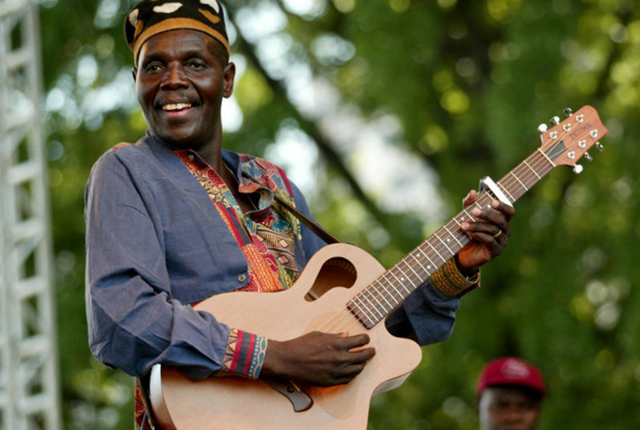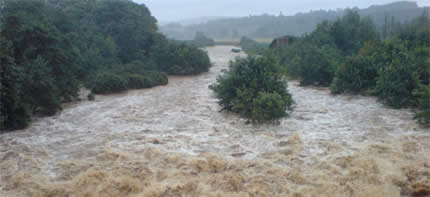Executive appointment of the Chief Justice . . .Thesis, antithesis and synthesis


Outgoing Chief Justice Godfrey Chidyausiku swears in President Mugabe in this file picture. The appointment of a new Chief Justice is the subject of heated debate in the legal fraternity
Sharon Hofisi Correspondent —
Broadly speaking, amending the Constitution is steeped in the debate between those who see the need to correct flaws created by the original drafters, and those who see the supreme law as a living document which should be interpreted by each successive generation.
Both views are measured in historical and international terms and are usually a product of reform and adaptation.
It is this that links the inexorableness of the Executive model of appointing the Chief Justice (CJ) in Zimbabwe – given impetus by the gazetting of Constitutional Amendment Bill (No. 1) – and the numerical legislative control that the ZANU-PF Government currently enjoys in Parliament.
The thesis in the executive model is now almost universally acknowledged: it is meant to ensure that at least two separate institutions with separate functions can check on each other.
This position holds whether the frame of reference is the Westminister (as the British model is popularly called); American or country-specific-like Zimbabwe.
An emerging judicial globalisation or trans-jurisdictional approach, sculpted by Professor Anne-Marie Slaughter is insightful in this regard as it explains the model from both “vertical” relations between national and international tribunals and “horizontal” relations across national borders.
In India for instance, the proviso to Article 124 (1) makes it mandatory that the President consults the CJ before the appointment of any judge other than the CJ.
The looming constitutional amendment by the Government of Zimbabwe (GoZ) proceeds from the international developments that treat the CJ as more than an ordinary judge.
Political appointees for key positions in the judiciary are not new the world over.
President George W. Bush appointed Chief Justice John Roberts and Justice Clarence Thomas, an Associate Justice of the Supreme Court of America.
In the UK, the Lord Chief Justice John Thomas was appointed by Her Majesty the Queen on the advice of the Prime Minister, Deputy Prime Minister and the Lord Chancellor following the recommendations of an independent selection panel.
Across the Limpopo, Richard Calland’s book, “The Zuma Years: South Africa’s Changing Face of Power”, provides critical political reasons as to why long-serving Deputy Chief Justice (DCJ) Dikgang Moseneke was not appointed in 2011 and Justice Mogoeng Mogoeng was appointed and referred to as the Clarence Thomas of SA.
DCJ Moseneke was made to chair the JSC hearing that oversaw the appointment of CJ Mogoeng.
He had twice been overlooked for CJ and Calland states that disappointment must surely have tested his suave sangfroid because first, President Zuma appointed Justice Sandile Ngcobo after CJ Pius Langa’s term of office came to an end in mid-2009. Moseneke was then a sitting DCJ.
His second failure has been attributed to his political views on Polokwane where he remarked on equality that: “It’s not what the ANC wants or Polokwane delegates want; it is about what is good for the people.”
According to Calland, Moseneke unnecessarily created a natural tension amongst the political branches (what is commonly called separation of powers/trias politica or separation of functions) in South Africa and consequently, President Zuma could not appoint him.
The antithesis to a direct political model is that making judges executive appointees would interfere with their independence.
An indirect approach that involves the JSC or some commission tasked with this mandate would be ideal.
A pertinent question in this regard would be: How best to ensure executive accountability in the appointment process?
Put differently: Do we need direct appointment of the CJ by the executive?
Interestingly, an informal survey that was carried out in 27 Asian countries in 2003 by USA Justice Clifford Wallace revealed that some countries appoint a CJ pursuant to a constitutional or statutory mandate.
The vast majority of the surveyed countries thrust this decision directly to the chief executive, the legislature, a special committee, or some combination of the three. India and Thailand were found to employ a seniority system, while Mongolia invites 11 justices to select their own leader.
Whatever model was preferred in the respective countries surveyed, few of the CJs had substantial experience on the highest court before their appointments.
Zimbabwe can still choose a workable model from the Wallace survey.
From the survey, only seven CJs had served as associate justices for more than two years, and over half had no prior experience on the highest court at all.
Some of the surveyed countries had smaller sizes on their highest courts, except for China with 330, and Thailand with 85.
The applicability of the Mongolian model to Zimbabwe would, for instance, be affected by the composition of the Judicial Service Commission (JSC) which has both legal and non-legal members.
The Chinese-Thailand model would still be difficult to adopt since it would mean appointing the current DCJ, Justice Luke Malaba as the most senior of the four candidates.
Inasmuch as this would allow for an indirect appointment by the President, it may disqualify the other candidates who could also be equally competent or senior such as Justices George Chiweshe, Rita Makarau and Paddington Garwe.
Transforming the current situation in typical Mongolian style could still be practicable in the Zimbabwean constitutional context where the President can still reject the list so forwarded to him by the JSC.
Even if the GoZ had allowed the interviews to continue, the President could have rejected the list.
From the foregoing pitfalls endemic in indirect appointments, scholars like James Allan believe that direct appointments are workable since: firstly, one political party (like ZANU-PF in our case) would be accountable for selection.
Secondly, there is openness for choosing another male or a former politician (in the event that the President does not appoint any of the four candidates that were being interviewed before the legal challenge was mounted to suspend the interviews).
Thirdly, a less activist type of judge or someone with unorthodox views on the proper way to interpret constitutional provisions can be deliberately and consciously taken (a thorough scrutiny of the constitutional interpretations in key cases would be needed in this regard).
Above all, a direct model forces the Government and its Attorney-General to live with the political ramifications of such a decision.
The AG is the chief legal advisor to Government, and as such, the attack on the political model is seen as one on the AG rather than members of a JSC who mostly serve as apolitical.
It is usually Herculean for ordinary citizens to tell judges that they derive their judicial authority from the people, even though the Zimbabwean Constitution specifically says so.
The electorate can, however, afford to do so with other arms of Government through the ballot.
The antithesis is prodigiously explained by the concerns in the South African legal fraternity that former CJs in SA, Chalkalson and Langa, were appointed because of their willingness to broker political compromises.
This has been buttressed by legal challenges to the extension of CJ Ngcobo’s term as a thoroughly rotten idea constitutionally in that: it was bad practice to change the law in favour of one person.
Cumulatively, the extension was seen as recipe for bad governance since the CJ could steer judgments in favour of the executive or create a perception that he was doing so.
The drafters could still have adopted the SA position by pegging CJ’s retirement age at 75.
This would have allowed the current CJ, who retired at 70, to establish an office of the CJ as is the case in SA.
Axiomatically, the synthesis in this paper noticeably accepts that the Zimbabwean scenario should follow constitutional reforms in other countries where the constitutional provisions relating to the appointment and roles of the CJ include similarly couched vacuous references meant to allow the CJ to exercise considerable discretion in apportioning time among adjudication, administration, and other functions; to an extent that his role remains “work-in-progress” in most jurisdictions.
His appointment should remain a merit-based appointment (MBA).
Admittedly, it is quite Herculean to separate the appointment process from both ordinary and constitutional politics.
During the recent US election that was subsequently won by Donald Trump, Bill Mears had written in October 2016 on how Trump thought Justice Clarence Thomas is “very strong and consistent” and his list of potential political appointees included a whole mix of conservative judges-both state and federal judges.
Trump’s rival, Democrat’s Hillary Clinton’s “loved” idea of a Justice Barack Obama.
Obama could have been politically appointed to fill the court vacancy left by Antonin Scalia’s death had Clinton won the election.
This was notwithstanding the fact that President Obama himself had preferred Judge Merrick Garland but could not get the Senate vote to appoint him.
An MBA model has been taken to include is eight qualities and skills on a judge which include: Analysing and decision-making; legal knowledge and expertise; integrity and independence; authority; leadership and administrative duties; managing workload; communicating; and treatment of others.
Most of these skills are noticeable in all the four candidates that were currently being interviewed by the Judicial Service Commission.
What is needed is a thorough MBA consultation that would reliably inform the President when appointing the highest custodian of the constitution as the mirror of the nation’s soul.
It is suggested that the envisaged executive model must also be informed by the findings in the Wallace survey which include: the CJ’s prior judicial experience, his or her oversight authority on associate justices and lower courts; roles in judicial training, discipline, judicial administration, communications with the media, and relations with the executive, legislature, and the bar.
The meteoric appointment of CJ Mogoeng in SA, who started as a public prosecutor, went to the bench where he became justice president and also sat as a constitutional judge where howls of protests from human rights sector were made because of his views on sexual offences, is understood from the ANC‘s or President Zuma’s perception of DCJ Mogoeng as: one who was not ANC during his distinguished career as a lawyer prior to1994, but a member of PAC.
Alternatively, Parliament could be given powers in the wake of the envisaged amendment in a similar way the US-Congress can block a presidential nominee.
Alternatively Section 174(3) of the SA Constitution can provide insight since the president can appoint a CJ after consultation with the JSC and the leaders of the political parties represented in the National Assembly.
In legal parlance, “after consultation” could be discarded as being-weaker on the basis that it could be interpreted to mean simply informing the other party of the executive intentions which can still proceed even if the other parties are against you.
It could be replaced by the phrase “in consultation with”, which allows the parties to decide together through some sort of veto power.
There is also urgent need by the GoZ to establish an Office of the Chief Justice (OCJ) as a national department.
SA President Zuma proclaimed establishment of an OCJ on August 23 2010.
The purposes and objectives of the SA OCJ for instance include: to ensure that the CJ can properly execute his mandate as both the head of the Constitutional Court and head of the judiciary; to enhance the institutional, administrative and financial independence of the OCJ; and to improve organisational governance and accountability and the effective and efficient use of resources.
Added to the objectives are values which ensure that there is accountability to the judicial branch of government and the people of South Africa and need to foster public confidence in the judicial branch of government and the rule of law by upholding the values that ensure the: respect and protection of the Constitution, honesty and integrity, openness and transparency and professional ethics.
Sharon Hofisi is a lecturer of Administrative Law at the University of Zimbabwe and is contactable at [email protected].









Comments